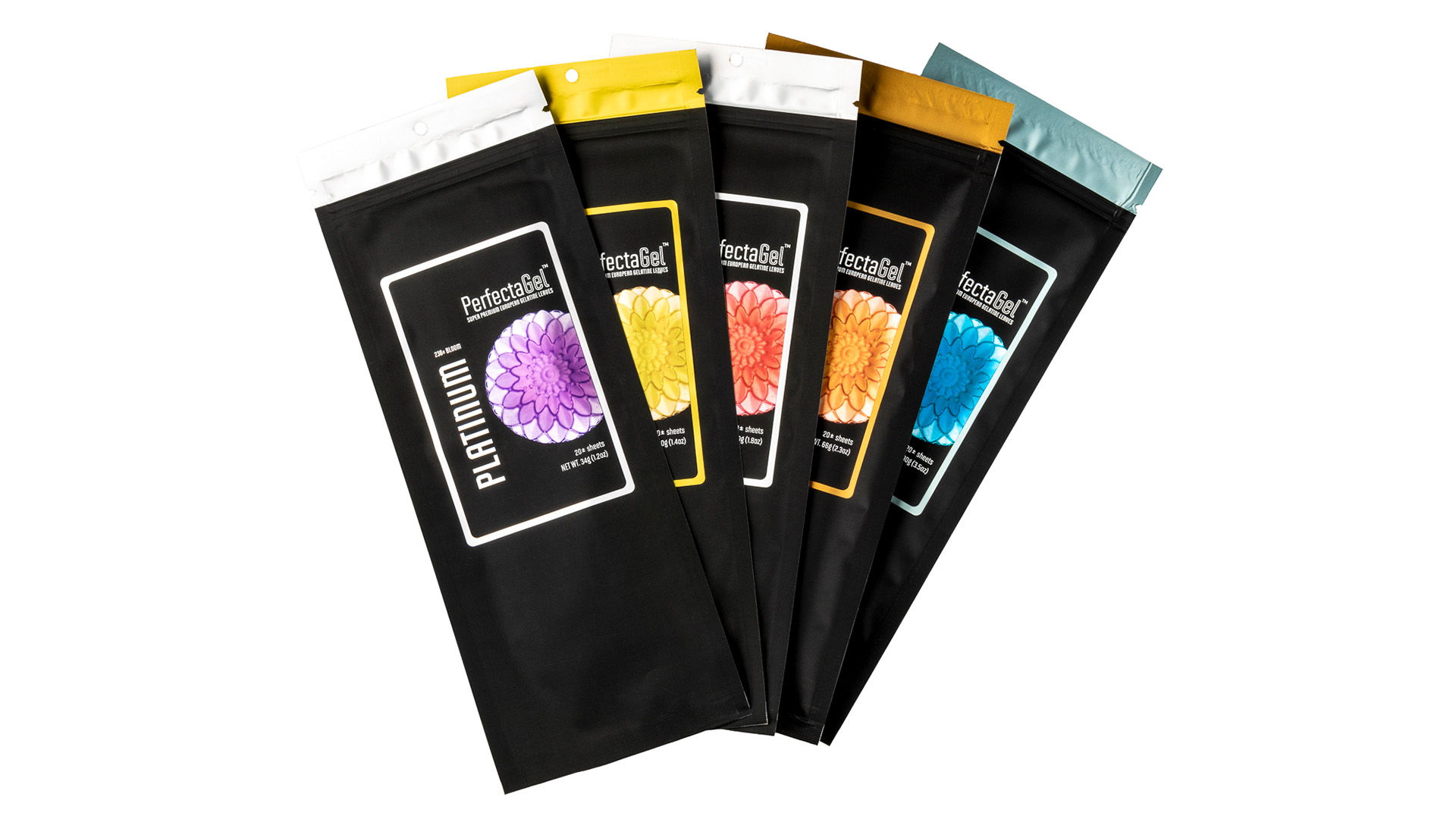Table Of Contents
| 1a. Sheet Gelatin | |
| 1b. Powdered Gelatin | |
| 2. Gelatin Substitutes | |
| 3. Sugar Substitutes | |
| 4. Culinary Acids | |
| 5. Flavor Drops | |
| 6. Emulsifiers | |
| 7. Coating | |
| 8. More Gummy Course Content |
Sheet Gelatin
When replacing one type sheet gelatin with another
Each sheet of sheet gelatin is measured to be the same gelling equivalent as another. For example one sheet of platinum will gel the same as one sheet of titanium. This works for all the sheets you see here. The clarity of the gel, the flavor and the weight of the sheet are all that differs.
PerfectaGel Sheet Gelatin
PerfectaGel is Super Premium Leaf Gelatin made in Germany. It is the only Platinum Grade gelatin available in the US. It is unflavored and can be used in both sweet and savory dishes.
Professional chefs prefer leaf/sheet gelatin because it makes a clearer product with purer flavor and is easier to use. You can just count sheets rather than weighing out powder and there is no chance of undissolved granules.
PerfectaGel is made of 100% Grade “A” Collagen from Pork. It is not appropriate for vegan, kosher or halal dishes.
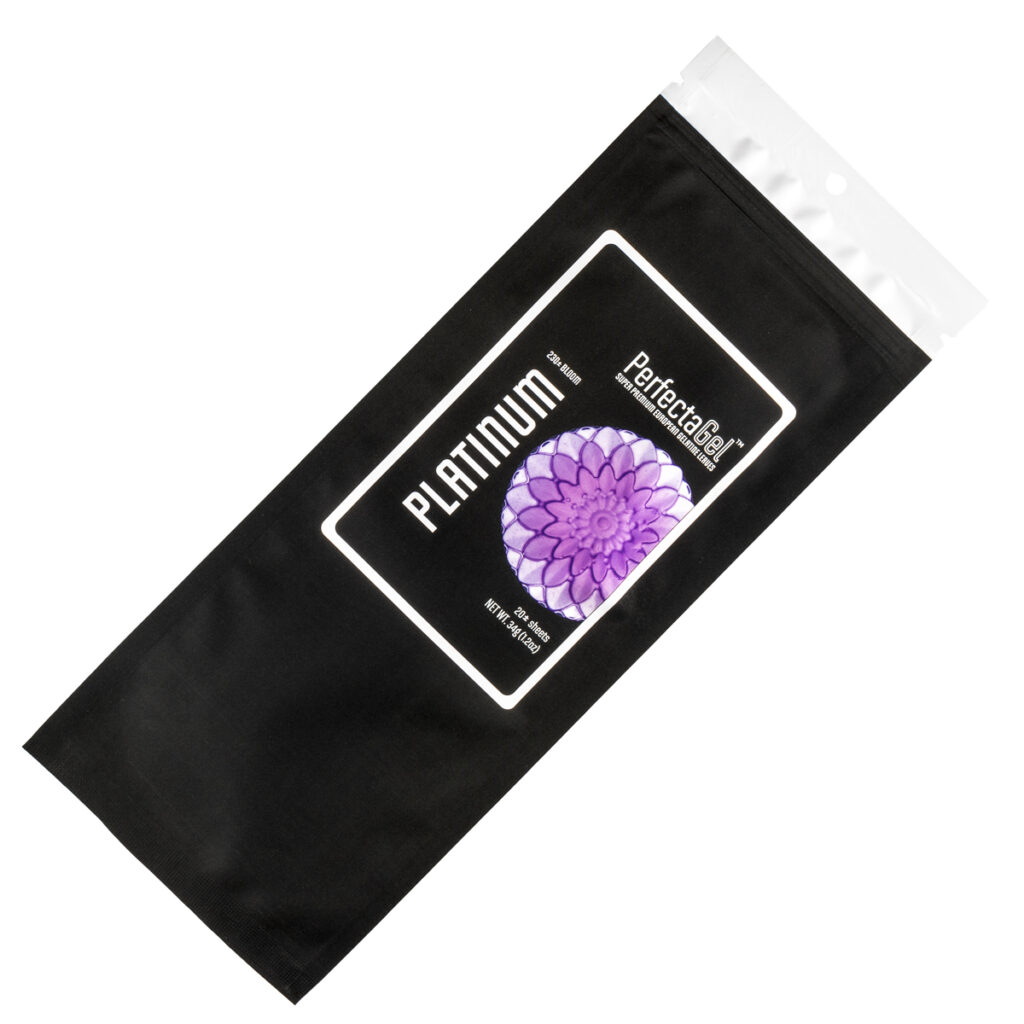
PerfectaGel Platinum
- 100% Grade A Porcine gelatin, 230 Bloom
- Sheet gelatin provides a clearer, higher quality gel compared to powder gelatin
- Platinum has an extremely clean mouthfeel and highest possible clarity
- Recommended for usage in applications where clarity and clean flavor are important
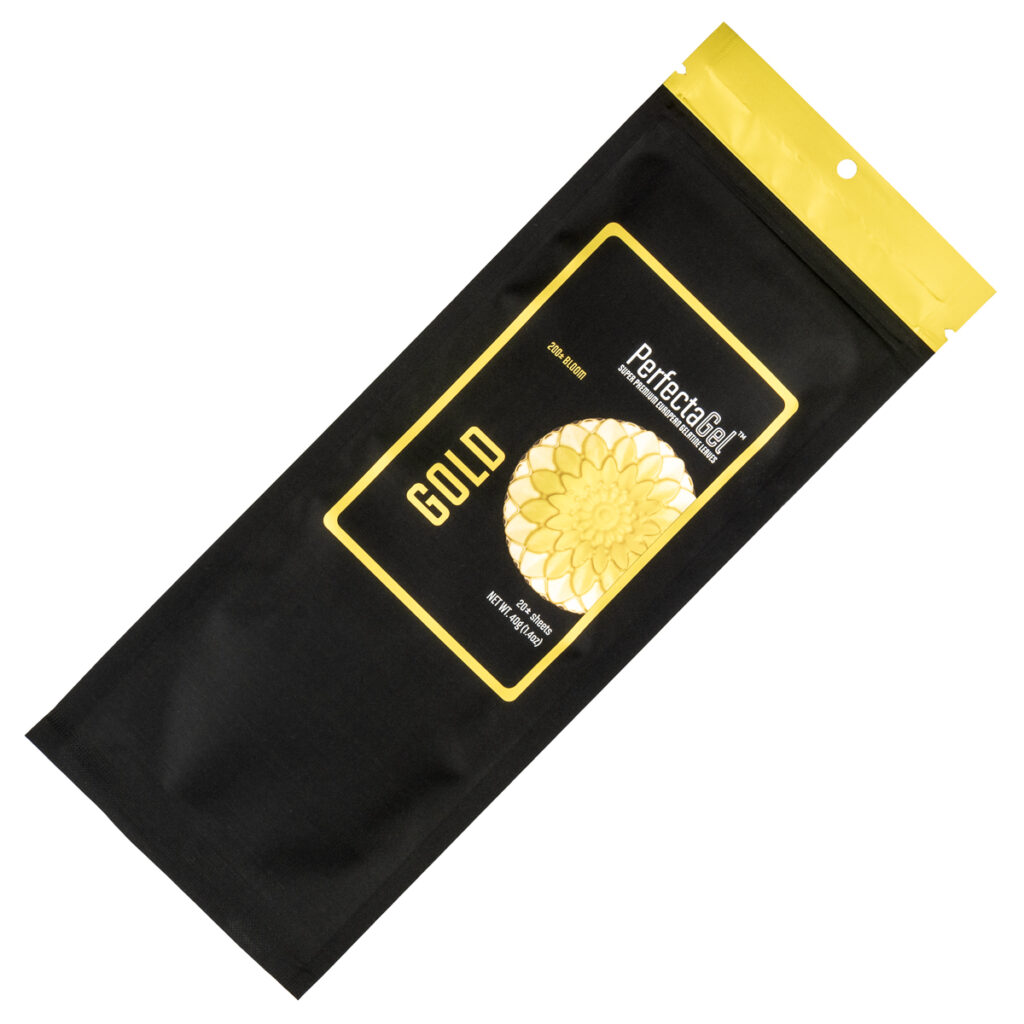
PerfectaGel Gold
- 100% Grade A Porcine gelatin, 200 Bloom
- Sheet gelatin provides a clearer, higher quality gel compared to powder gelatin
- Gold has a clean mouthfeel and excellent clarity
- Recommended for usage in applications where clarity and texture are important
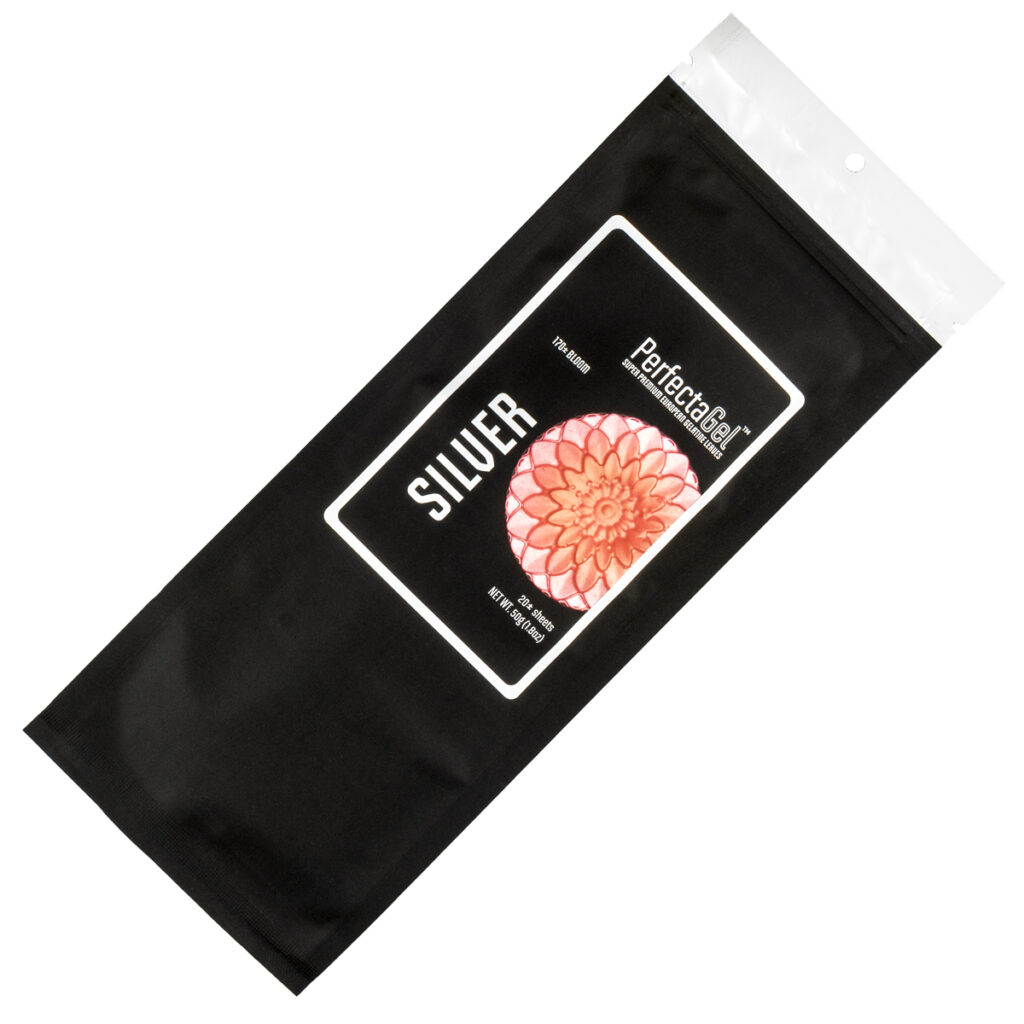
PerfectaGel Silver
- 100% Grade A Porcine gelatin, 170 Bloom
- Sheet gelatin provides a clearer, higher quality gel compared to powder gelatin
- Silver has great mouthfeel and high level of clarity
- Recommended for usage in a mix of savory and sweet applications
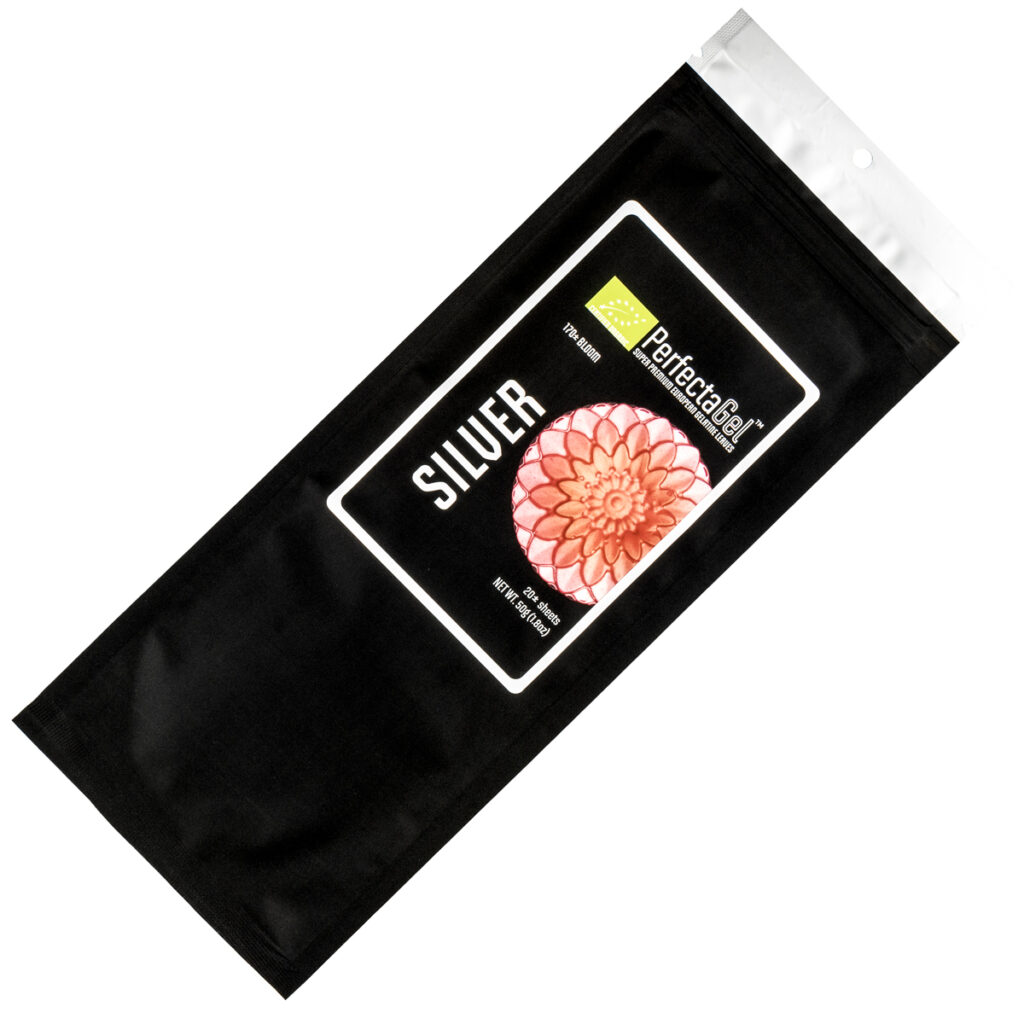
PerfectaGel Silver (organic)
- 100% Organic Grade A Porcine gelatin, 170 Bloom
- Sheet gelatin provides a clearer, higher quality gel compared to powder gelatin
- Silver has great mouthfeel and high level of clarity
- Recommended for usage in a mix of savory and sweet applications
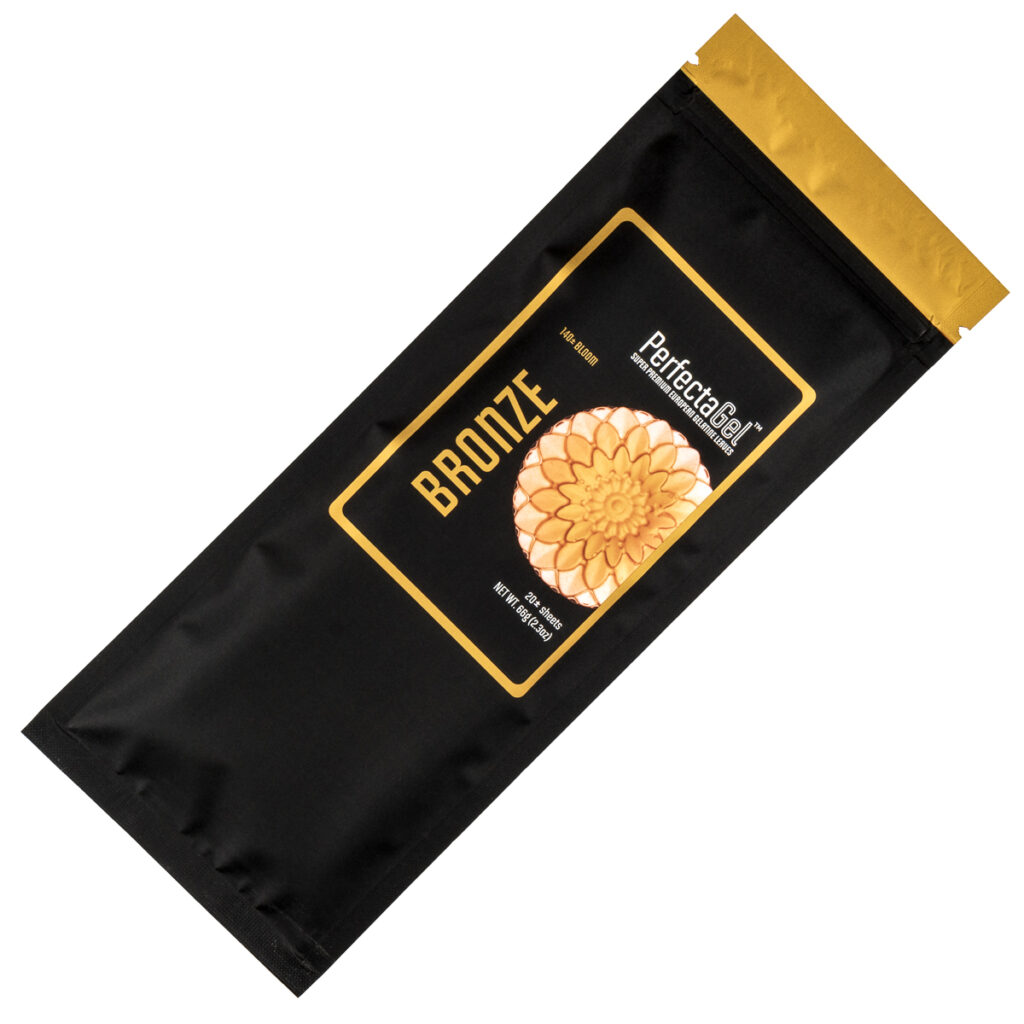
PerfectaGel Bronze
- 100% Grade A Porcine gelatin, 140 Bloom
- Sheet gelatin provides a clearer, higher quality gel compared to powder gelatin
- Bronze has a rich mouthfeel and good clarity
- Recommended for usage in a mix of savory and sweet applications
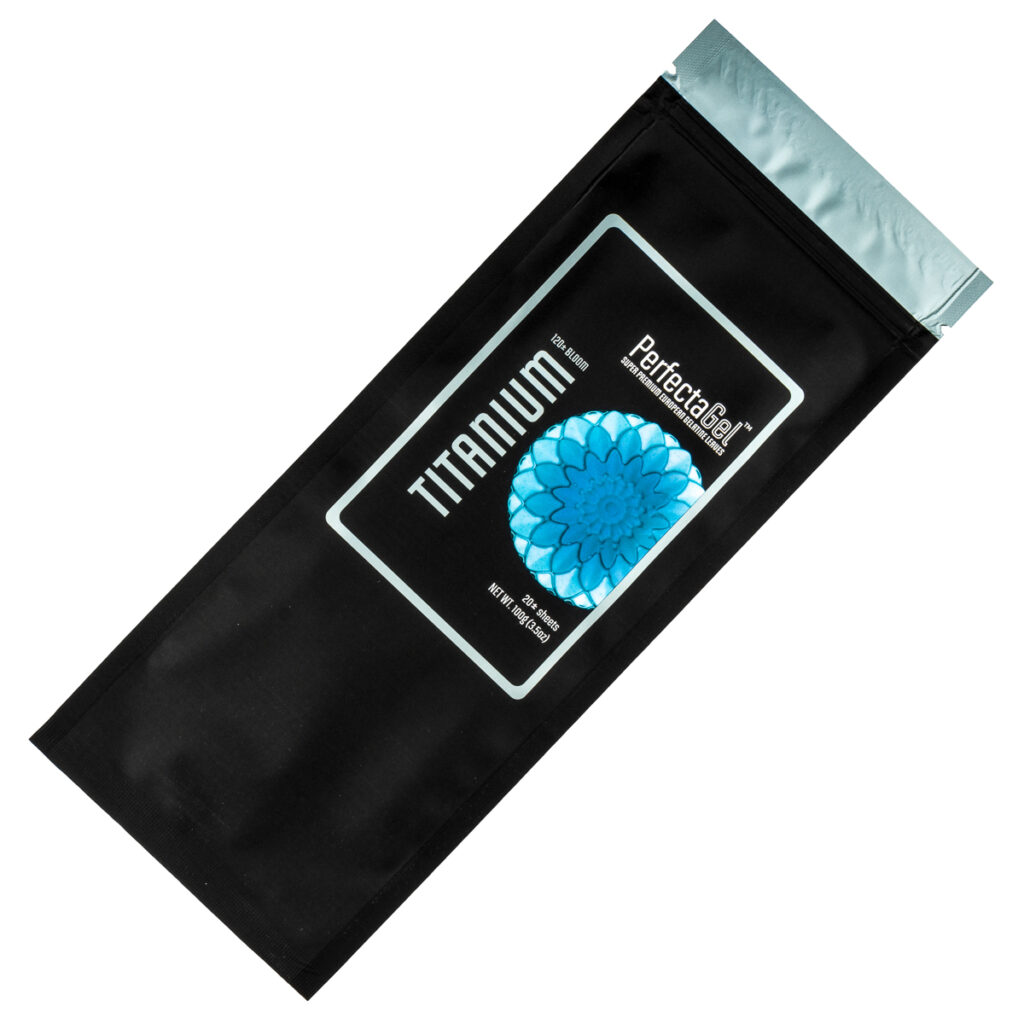
PerfectaGel Titanium
- 100% Grade A Porcine gelatin, 120 Bloom
- Sheet gelatin provides a clearer, higher quality gel compared to powder gelatin
- Titanium has a richest mouthfeel of all sheet gelatin
- Recommended for usage in savory applications where flavor is more important than clarity
Powdered Gelatin
Instagel® Cold Set Gelatin
Instagel® is a quick and convenient alternative to traditional gelatin that saves time, labor and equipment. It is especially well suited for dessert preparations and the perfect ingredient for modernist cocktails.
There are applications where the heating stage required to dissolve traditional gelatin complicates the processing or preparation of a recipe. And in some cases, a heating stage will actually negatively impact the desired result. Instagel®, cold soluble gelatin, solves this problem. It has exactly the same textural properties as traditional gelatin, which means that the unique melt-in-the-mouth effect, texture and mouth-feel remain unsurpassed.
Cold soluble gelatin will start dissolving as soon as it comes into contact with a cold liquid (water, milk, fruit juice, etc.). And because there is no heat involved in the preparation, it will immediately impact the viscosity, thickening or air entrapment of the preparation. Because of this, the finished product may be consumed much sooner than would be the case with traditional gelatin, which requires a longer cooling period.
When replacing gelatin with instagel follow the guide below
4g Instagel® dissolved in 6 times its weight of water = 1 soaked gelatin sheet or about 2g of dry powder gelatin that has been soaked.
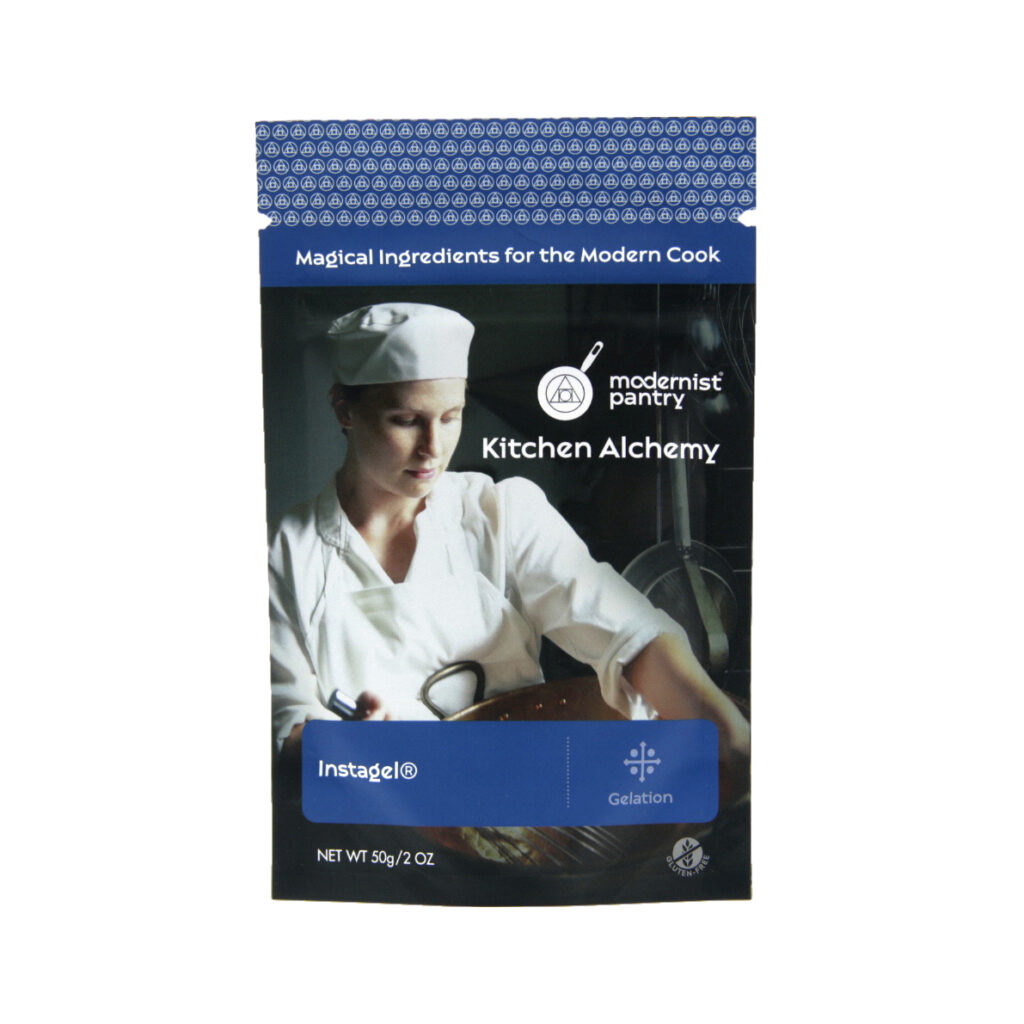
Instagel Cold Set Gelatin
- Gelatin sourced from pork
- Only cold soluble gelatin, no heat required
- Requires no blooming, just add and gel
- Substitute in 2:1 for regular powdered gelatin
Beef Gelatin
Gelatin is an odorless, tasteless thickening agent that forms a gel when combined with liquid and heated. It is thermo-reversible, which means that the gel liquefies when heated above its melting point but regains a jelly-like consistency when cooled again. The melting point of gelatin is close to the body temperature of the animal from which it is made, which for mammals is around 99F/37C.
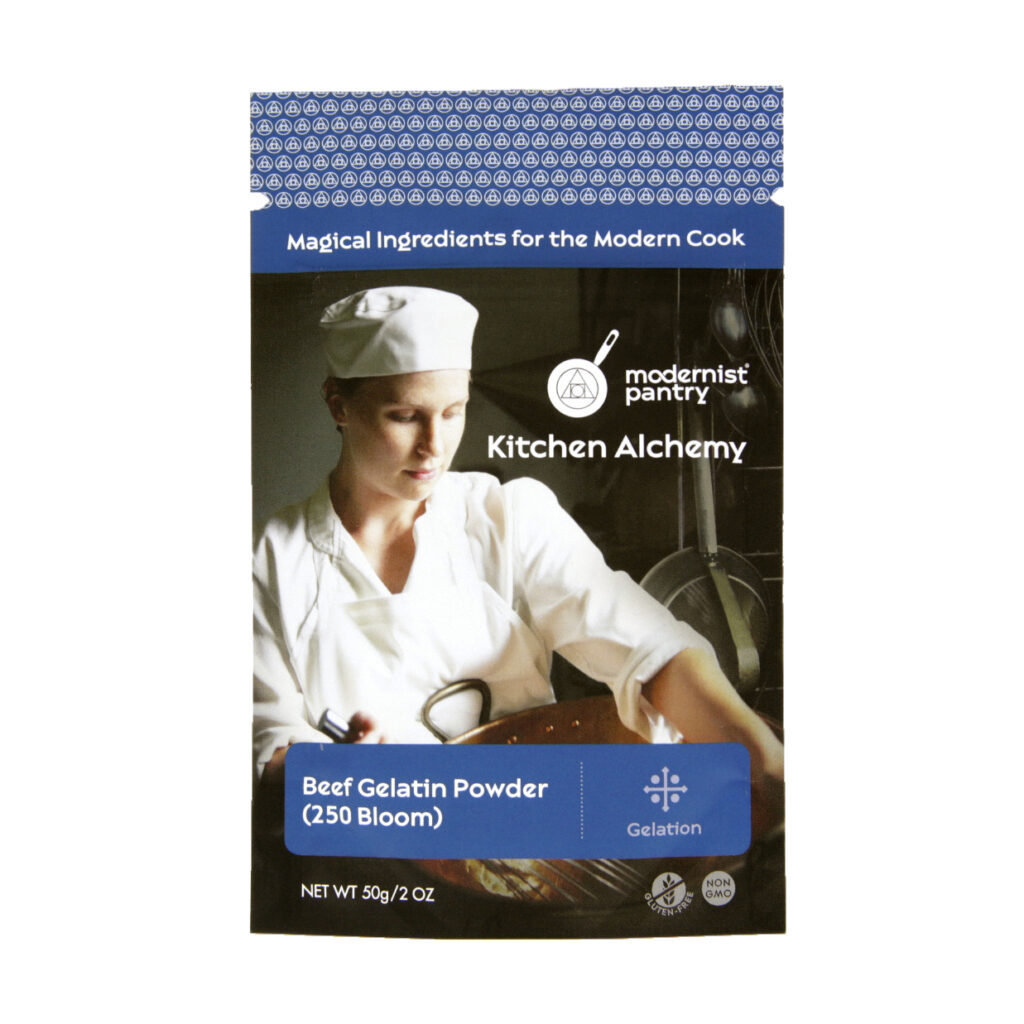
Beef Gelatin
- Bovine gelatin, 250 Bloom
- Highest quality available
- Suitable in applications where pork gelatin is not used
Fish Gelatin
Gelatin is an odorless, tasteless thickening agent that forms a gel when combined with liquid and heated. It is thermo-reversible, which means that the gel liquifies when heated above its melting point but regains a jelly-like consistency when cooled again. Fish gelatin has a very low melting temperature compared to other types of gelatin.
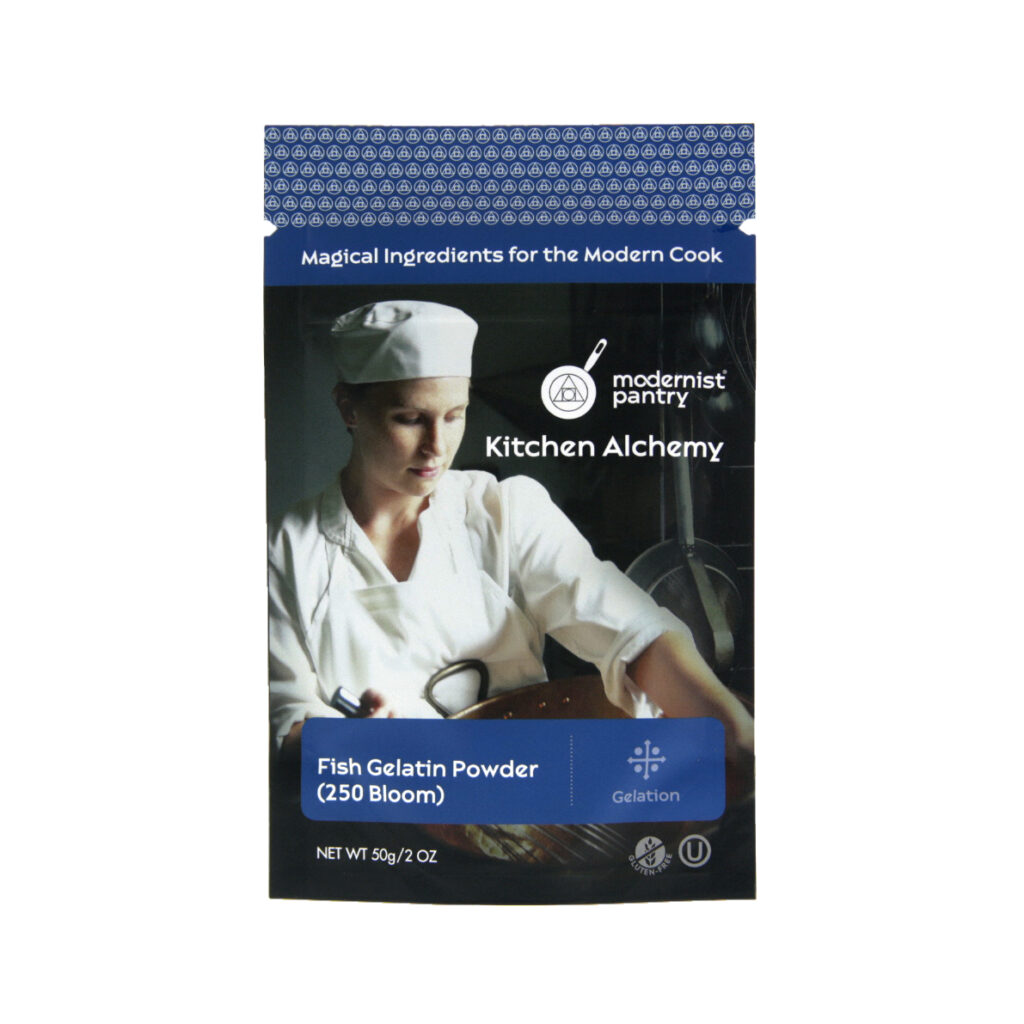
Fish Gelatin
- Gelatin sourced from farm-raised tilapia
- 250 Bloom for high gel strength
- Specialized for lower gelling and melting point
- Suitable in applications where pork gelatin is not used
- OU Kosher certified
Gelatin Substitutes
Druids Grove Vegan Gelatin*
Druids Grove Vegan Gelatin is a highly effective plant-based gelling agent that is often used as a substitute for gelatin. Druids Grove Vegan Gelatin allows you to follow recipes where animal gelatin is utilized without changing the results. One such common application is for confectioneries like jelly candies. Use Druids Grove Vegan Gelatin to create classics like gummy bears or marshmallows.
Druids Grove Vegan gelatin is a one to one replacement for powdered gelatin. This means that you can directly replace a powdered gelatin with Druids Grove Vegan Gelatin by weight. Druids Grove Vegan Gelatin does not require blooming and should be mixed with the sugar or other dry ingredients prior to use. This is the only change to any powdered gelatin recipe. Druids Grove Vegan Gelatin gels at a very high temperature, and we suggest keeping the mixture in a pan over low heat while filling any molds.
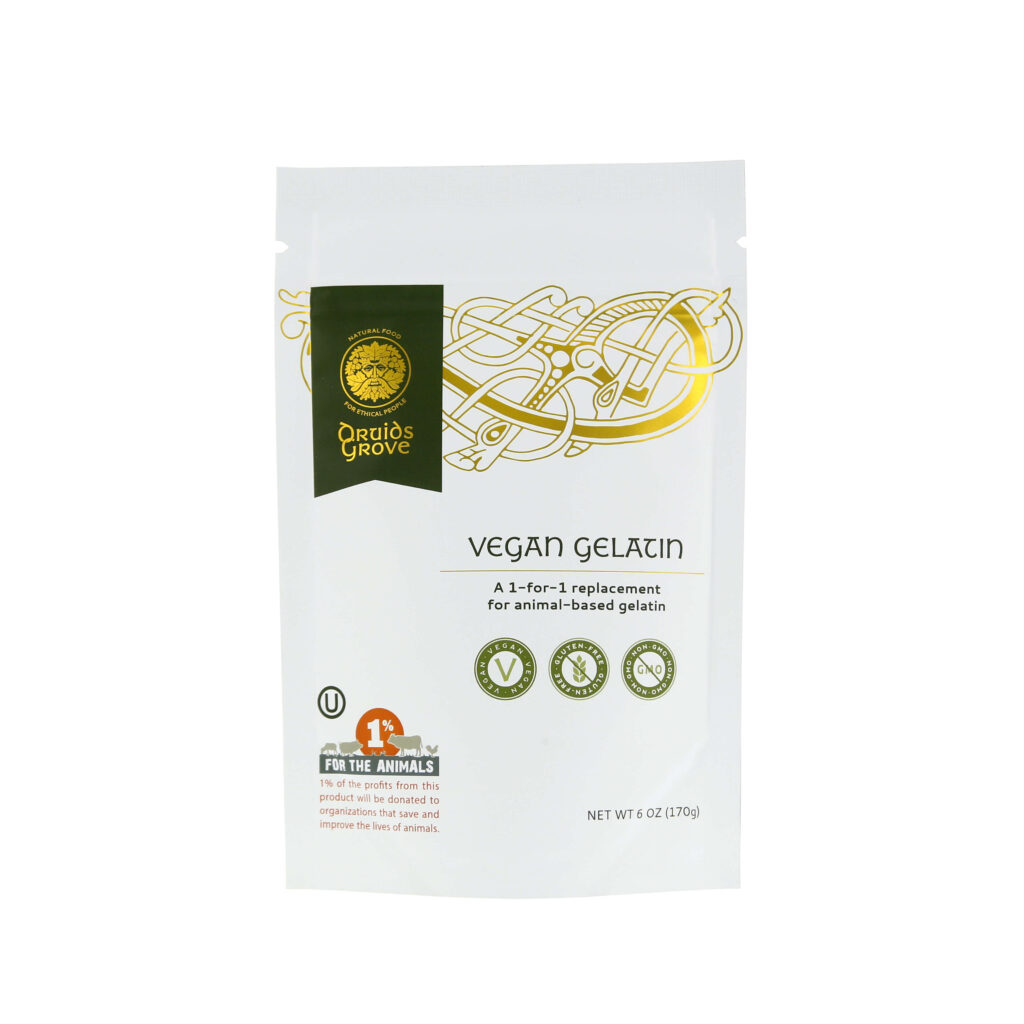
Vegan Gelatin
Specially blended mix of carrageenans to offer the unique elasticity and mouthfeel of animal gelatin
- Sub in 1:1 for animal gelatin (in most applications)
- Always dry mix Vegan Gelatin – do not bloom!
- Makes wonderful marshmallows, gummies, flan, and more
Super Agar
Super agar is a highly refined form of agar extracted from the Gracilaria species of red seaweed and is a popular gelatin-substitute for vegan applications. Also known as kanten, agar agar is derived from a bright red sea vegetable. An excellent gelling agent and thickener in many processed foods, agar agar forms gels at 88 F and does not melt below 136 F. Super agar is a much stronger form of agar compared to most agar agar products on the market.
To use super agar in place of gelatin you will need to change the method of the recipe. There is no exact conversion from gelatin by weight to agar. For a gummy like texture we suggest using between 2-4% of the total weight of the recipe. The super agar will need to be mixed into the sugar or dry ingredients in the recipe prior to heating. Gummies made with super agar will melt at a much higher temperature compared to gummies made with gelatin.
The texture of agar is not close to the texture of gelatin. Agar gummies will also have a brittle texture and less flavor release compared to gelatin. While it can be used as a replacement the final result will be very very different.
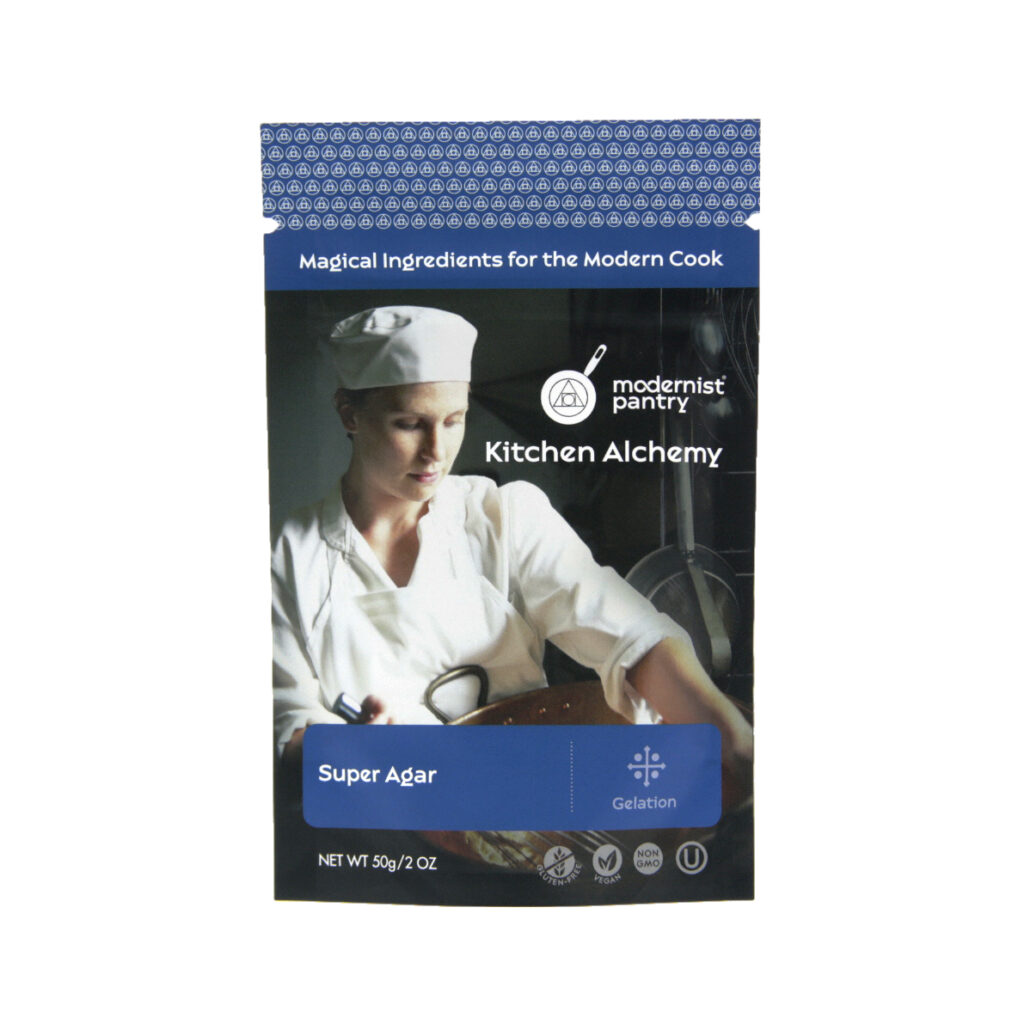
Super Agar
- Hydrocolloid sourced from high quality, refined Gracilaria red seaweed
- Creates brittle, non-elastic gels for jelly candies and fluid gels
- High gel strength for stronger gels, reduces weeping and crystallization
- Soluble at boiling point for 5 minutes
- Synergistic with locust bean gum to form firm, elastic gels
Sugar Substitutes
Allulose
Allulose is a crystalline low-calorie monosaccharide that is 70% as sweet as sugar. It can be used to substitute sugar in any low calorie and low-glycemic impact products. Allulose will caramelize at a lower temperature compared to sugar. Allulose provides all the taste and enjoyment of sugar without the calories, glycemic impact, or any off-putting flavors and after-taste.
Replacing sugar in gelatin gummy
Allulose can replace sugar in a gummy recipe easily but it may need to be scaled up by 30% to achieve a comparable level of sweetness to table sugar. Be sure to keep the mixture below 212°F as it will caramelize quickly in the presence of proteins.
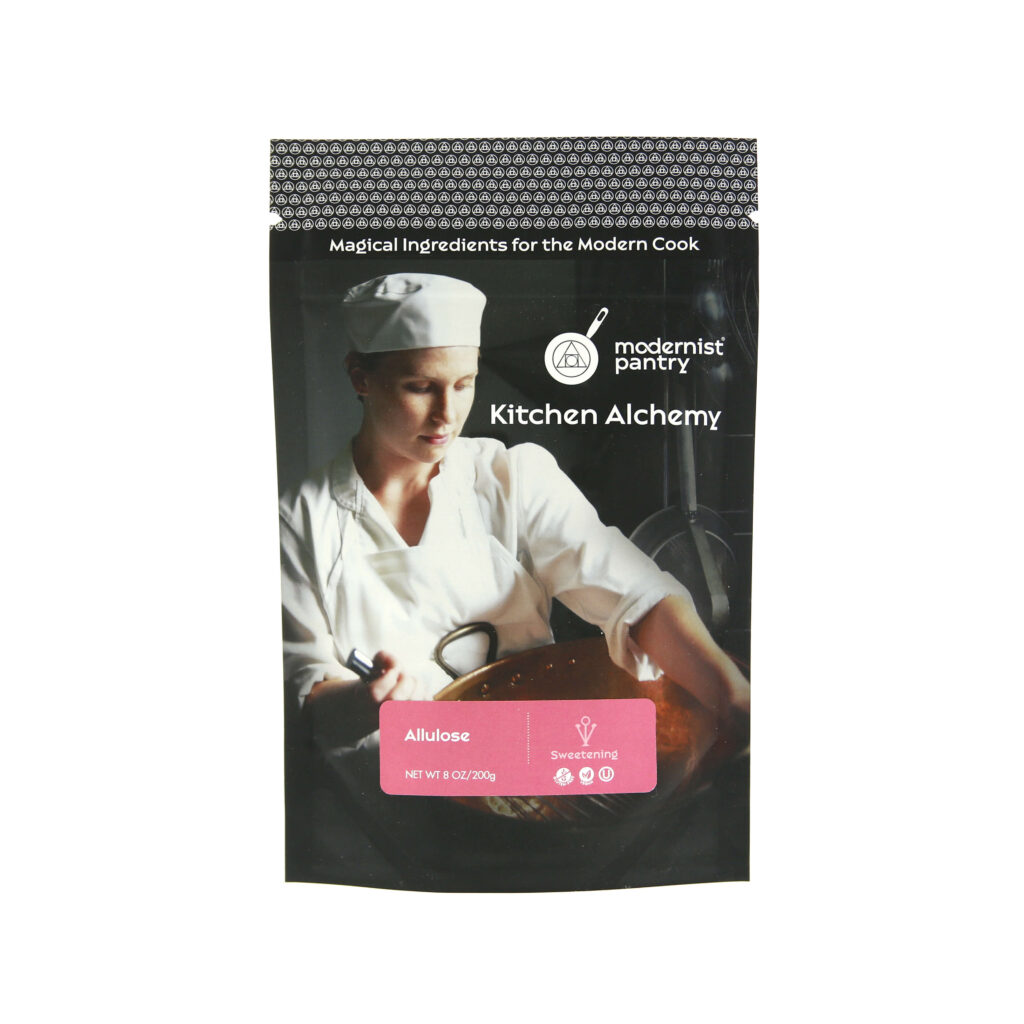
Allulose
- Rare sugar that has natural sweetness without any off flavors
- 70% as sweet as sugar
- Suitable for sugar free, low calories, and low glycemic index products
- Depresses the freezing point in frozen products
- Promotes browning in baking
Glucose DE 42
Glucose DE 42 Powder is about 40-45% as sweet as sucrose (table sugar). It has a dextrose equivalent (DE) of 42. Glucose DE 42 resists crystallization significantly better than sucrose or higher DE glucose. To reconstitute Glucose DE 42 powder into Glucose DE 42 Syrup, use a ratio of 80.5% Glucose DE 42 to 19.5% water by weight. Whisk constantly over low heat until dissolved, do not bring to a boil. Glucose DE 42 is not suitable in completely sugar-free recipes.
How to replace sugar in a gummy using DE42
Glucose DE 42 and syrup made from DE 42 can be used to prevent crystallization by replacing a portion of the sugar in both gelatin and pectin gummies. Glucose DE42 has less than half the perceived sweetness of table sugar. This means adding it to a gummy recipe will reduce the relative sweetness.
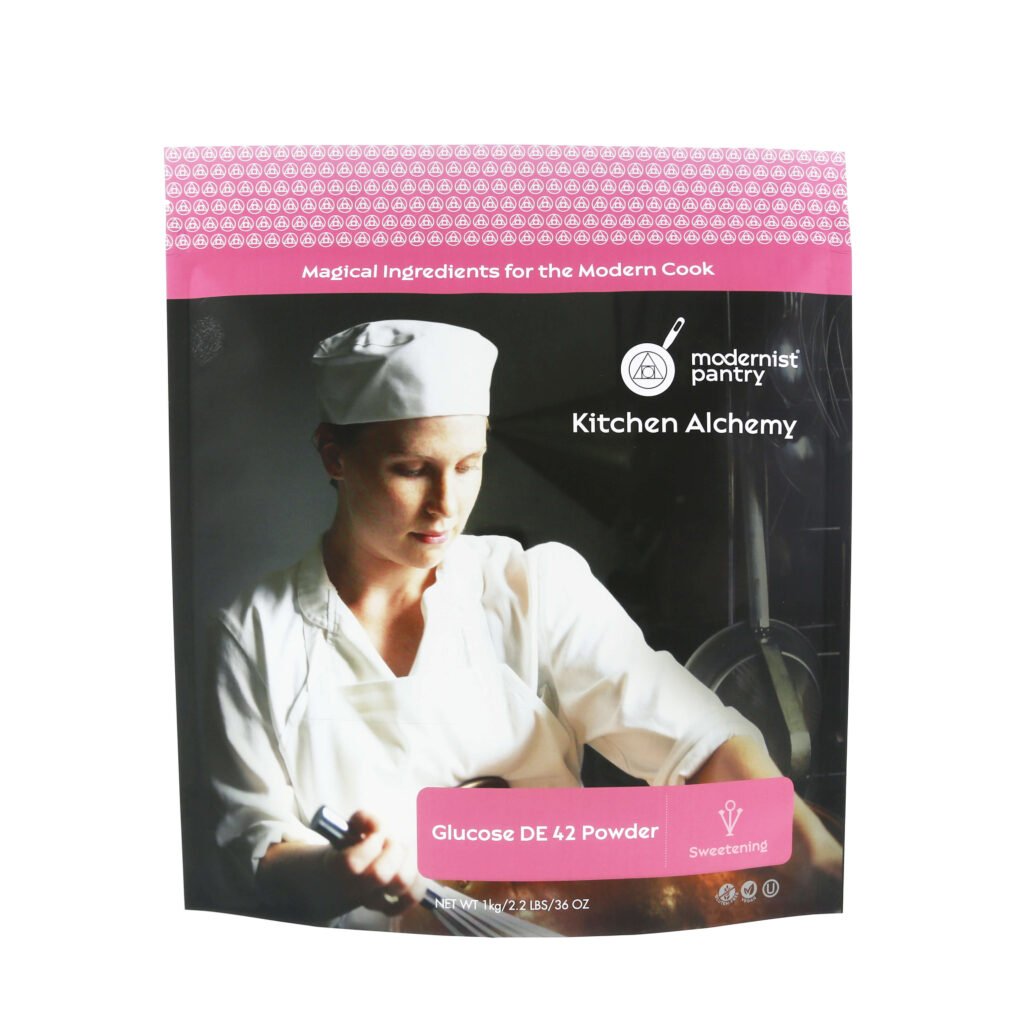
Glucose DE42
- Sourced from corn
- Approximately 40-45% as sweet as sugar
- Reconstitute into Glucose DE 42 syrup
- Use in baked goods and candies to prevent crystal formation
Sorbitol
Sorbitol is a corn derived sugar alcohol that is 60% as sweet as sugar. It is used in many sugar free, low calorie and diabetic products. Sorbitol will not brown or caramelize like sucrose.
Replacing sugar in a gelatin gummy
Sorbitol can replace up to 100% of the sugar in a gelatin gummy recipe. We prefer a mixture of 70% sorbitol and 30% xylitol for the best flavor. As with all the sugar substitutes sorbitol may need to be scaled up slightly to achieve the same sweetness as table sugar.
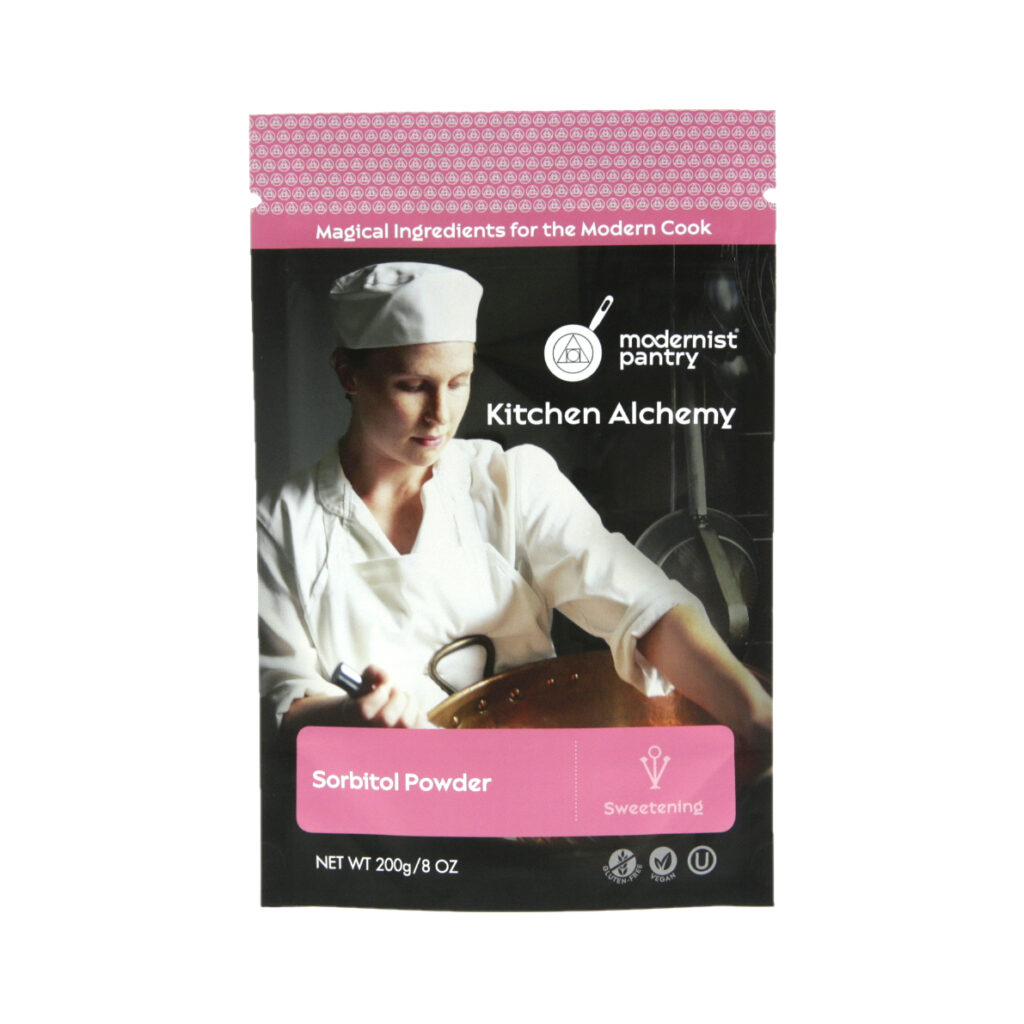
Sorbitol
- Sugar substitute sourced from corn
- 60% as sweet as sugar
- Popular in many gummy recipes
- Suitable for sugar free, low calories, and low glycemic index products
- Will not brown or caramelize
Xylitol
Xylitol is a sugar alcohol used for sweetening confections and other food products. It has no calories, making it a useful sweetener for diet foods. Xylitol has little to no effect on blood sugar and insulin and does not influence blood sugar levels.
Replacing sugar in a gelatin gummy
Xylitol can be used to replace 100% of the sugar in a gelatin gummy recipe. We prefer a mixture of 70% sorbitol and 30% xylitol for the best flavor. As with all the sugar substitutes, sorbitol may need to be scaled up slightly to achieve the same sweetness as table sugar.
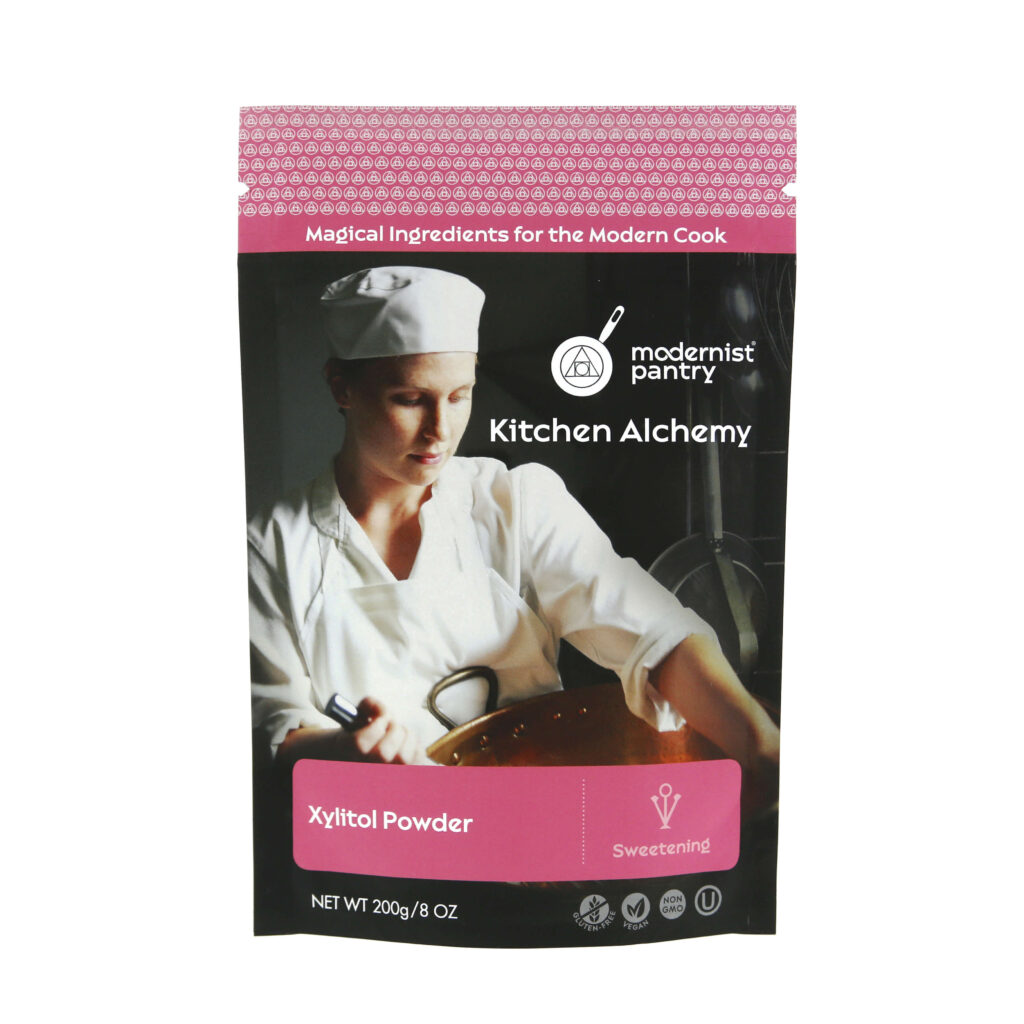
Xylitol
- Sugar substitute sourced from corn
- Similar sweetness to sugar
- Suitable for sugar free, low calories, and low glycemic index products
- Will not brown or caramelize, great for preventing crystallization
Isomalt
Isomalt is a natural sweetener and an excellent sugar substitute made from beet sugar. It provides the taste, texture and half the calories of sugar. It has sugar-like physical properties, can be used in a 1:1 ratio for granulated sugar, and provides the taste, texture and half the calories of sugar. Isomalt is a low digestible carbohydrate and may be suitable for individuals needing to control their blood glucose and insulin levels, or for lower calorie, healthier recipe alternatives.
How to replace sugar in any gummy recipe using isomalt
Isomalt can replace sugar in a gummy recipe one for one. It will create a gummy with reduced sweetness.

Isomalt
- Sugar substitute from sugar beets
- Widely used in sugar pulling and casting for cake decoration
- 50% as sweet as sugar
- High shine, does not crystallize like sugar
- Medium-sized granules, slightly hygroscopic
Culinary Acids
Citric Acid
100% Pure Citric Acid (e330) is a weak organic acid. It is a natural preservative/conservative and is also used to add an acidic, or sour, taste to foods and soft drinks. Citric acid exists in a variety of fruits and vegetables, most notably citrus fruits like lemons and limes. It can be added to ice cream as an emulsifying agent to keep fats from separating, to caramels to prevent sucrose crystallization, or to recipes in place of fresh lemon juice. Citric acid is commonly employed in wine production as a substitute or improver where fruits containing little or no natural acidity are used. It is one of several acids used by home brewers to modify brewing water for making beer. Additionally, citric acid is used as the main ripening agent in the first steps of making ricotta and mozzarella cheese.
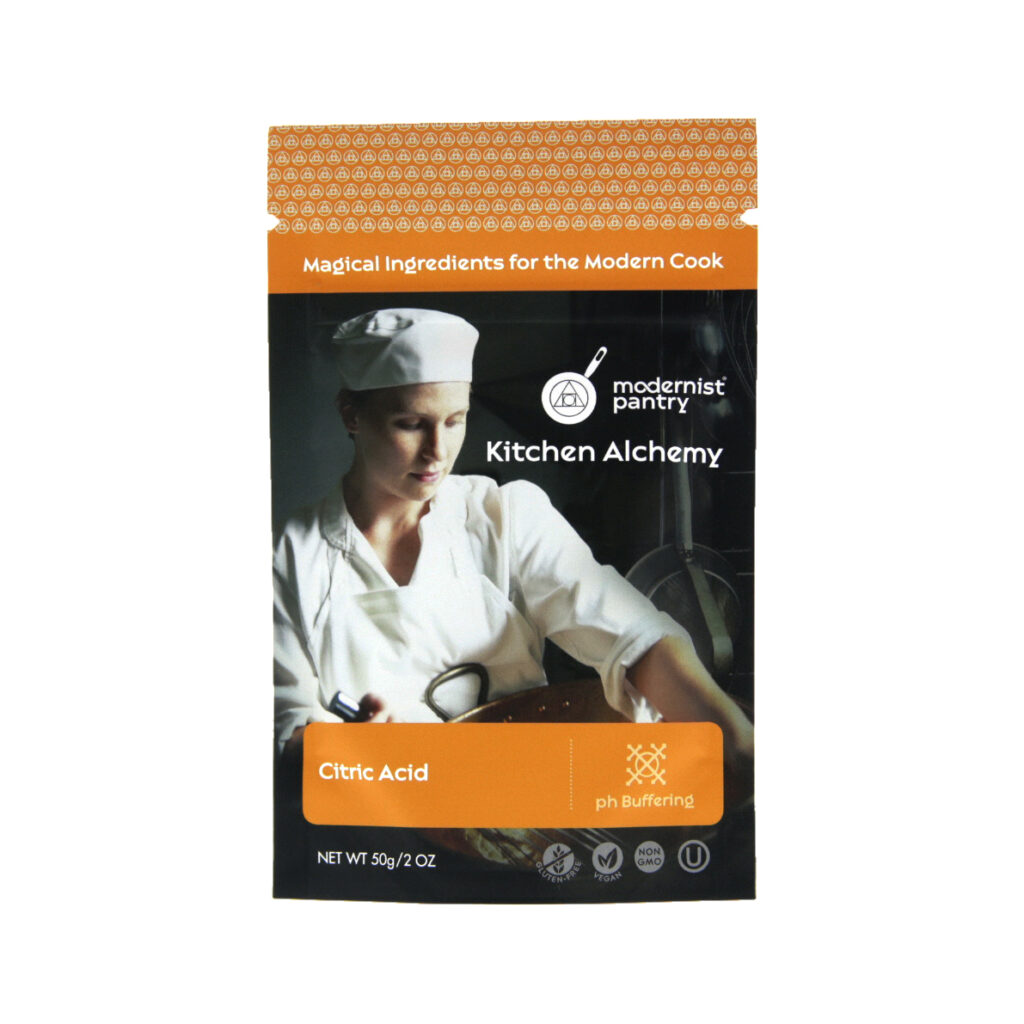
Citric Acid
- Anhydrous citric acid has a sharp, clean flavor
- Great for home-made cheeses and quick pickles
- Adds acidity without flavor where needed
- Acts as a flavor enhancer and sequestrant in food and beverages
- Cold/hot soluble in water
Malic Acid
100% Pure Malic Acid (e296) is an organic compound, which is the active ingredient in many sour or tart foods. In nature malic acid is present in large concentration on the apple skin and in a wide range of fruit and vegetable products, including plums, tomatoes, currant berries, bananas. In addition to being an acid regulator, malic acid is added to foods to give them a richer and more penetrating aroma. It is more tart than either ascorbic or citric acid.
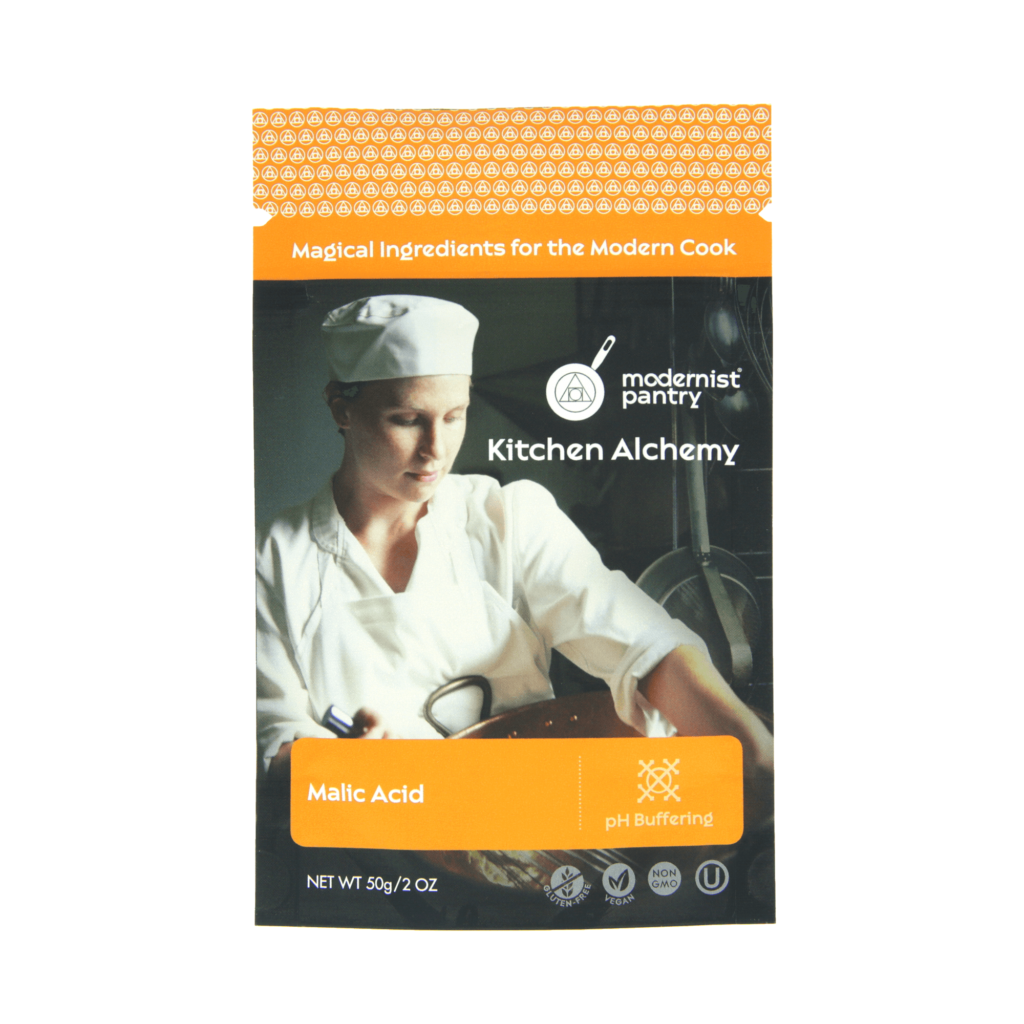
Malic Acid
- Commonly referred to as ‘fruit acid’ or ‘apple acid’
- Frequently used as an additive in beverages, bakery products, confectionaries, desserts, and as a preservative
- Can be added to foods to give them a richer aroma
- Provides a sharp, clean, acidic flavor
Tartaric Acid
100% Pure Tartaric Acid (e334) is a white crystalline organic acid. It occurs naturally in many plants, particularly grapes, bananas, and tamarinds; is commonly combined with baking soda to function as a leavening agent in recipes, and is one of the main acids found in wine. It is added to other foods to give a sour taste, and is used as an antioxidant.
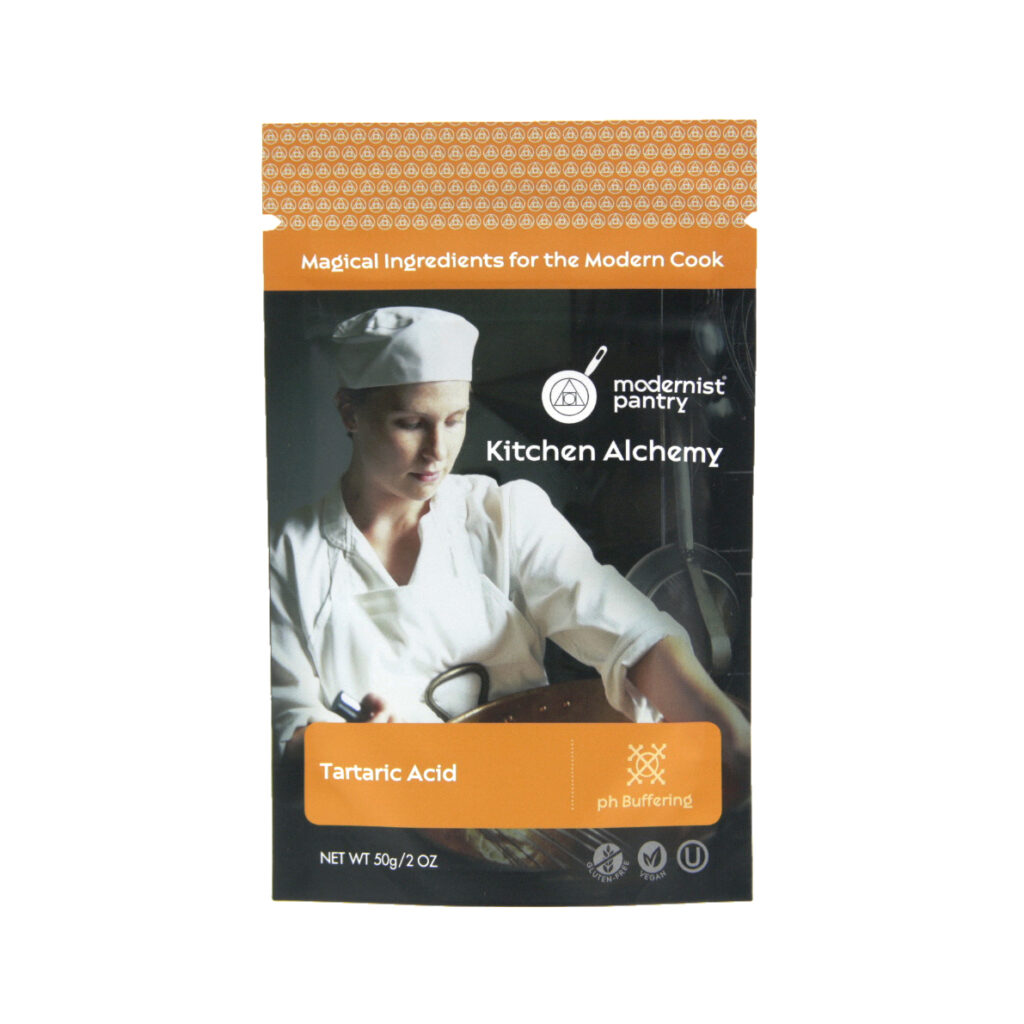
Tartaric Acid
- Sourced from grapes
- Frequently used in candies, gummies
- Useful for general promotion of acidity
- Provides a sharp, clean, acidic flavor
Flavor Drops
Culinary Crystals flavors are super strength flavoring extracts (5x stronger than grocery store extracts). Their flavor is so concentrated, only 2 to 3 drops are required per ounce of candy. In addition, these flavorings can be used for a wide variety of other applications including other hard candy, gourmet chocolate, fudge, frosting, fondant, coffee, tea, home-made soda, and vitamin waters.
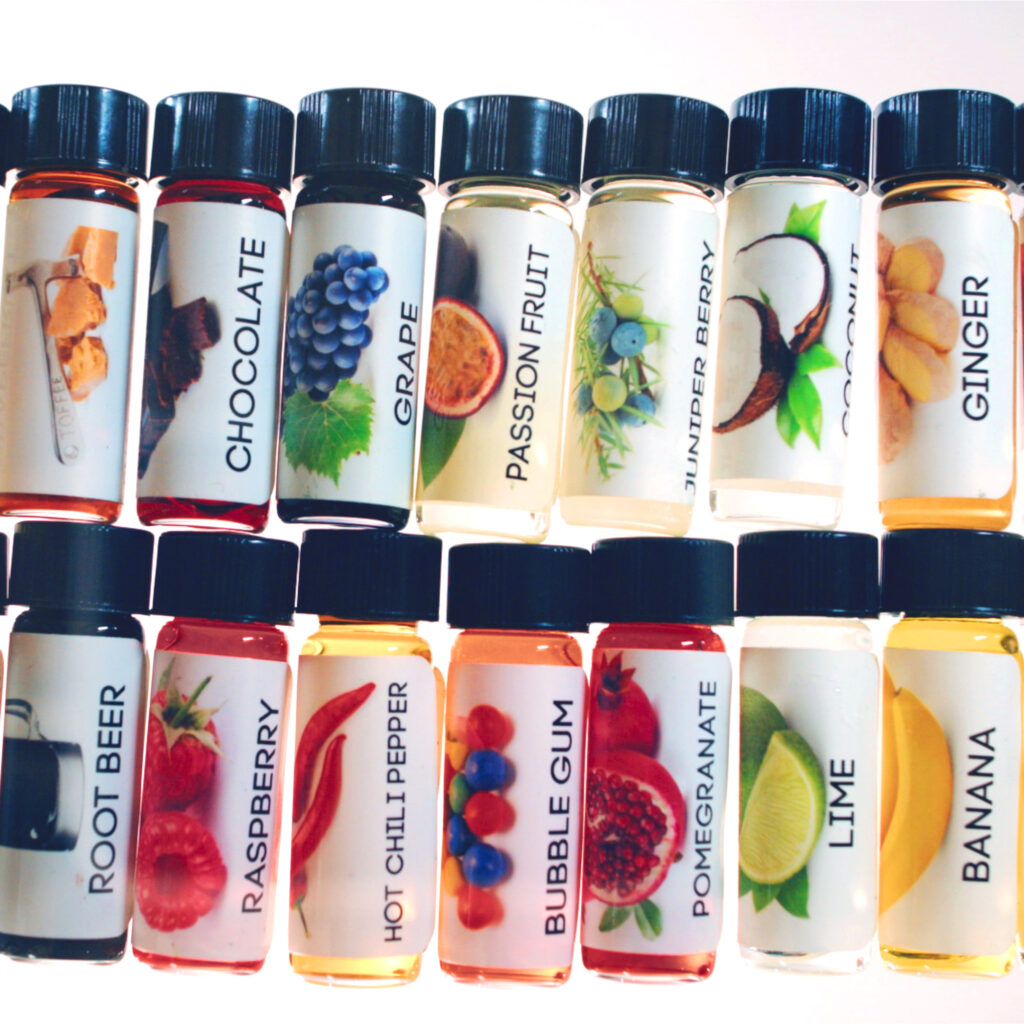
Flavor Drops
- 5x the intensity of other flavorings
- Flavor doesn’t change once heated
- Available in dozens of flavors
Emulsifiers
Polysorbate 80
Polysorbate 80 is a nonionic surfactant and emulsifier derived from polyethoxylated sorbitan and oleic acid, and is often used in foods. It can be used as a foaming agent to make spumas or airs. It is also added as an emulsifier in foods, particularly in ice cream, where polysorbate is added to up to 0.5% concentration to make the ice cream smoother and easier to handle, as well as increasing its resistance to melting. Polysorbate prevents milk proteins from completely coating the fat droplets. This allows them to join together in chains and nets, which hold air in the mixture, and provide a firmer texture that holds its shape as the ice cream melts.
Warning: If you are using polysorbate in any food application, make sure you the using food grade version sold here. Do not buy cheaper cosmetic grade which is widely available for use in soaps and other beauty applications.
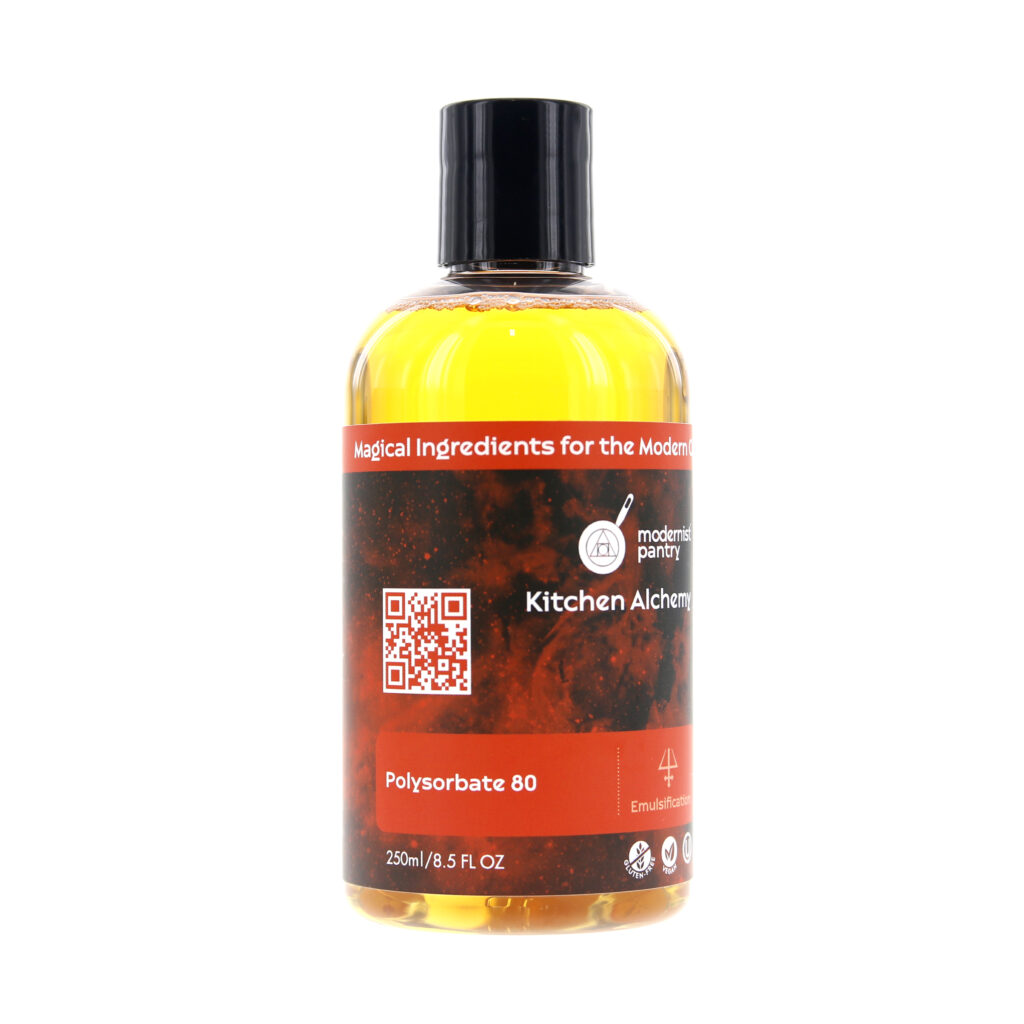
Polysorbate 80
- Sourced from corn
- Potent emulsifier for dressings, ice creams and much more
- Foams liquids to make spumas and airs
- Increases ice cream’s resistance to melting
Liquid Soy Lecithin
A natural phospholipid from soybean, Liquid Soy Lecithin (E322) is an emulsifying agent that helps fat and water stay together. It is often added to foods, such as chocolate, cheese, margarine, and salad dressing. It has health benefits such as reducing cholesterol level. Liquid Soy Lecithin is very viscous compared to powdered soy lecithin.
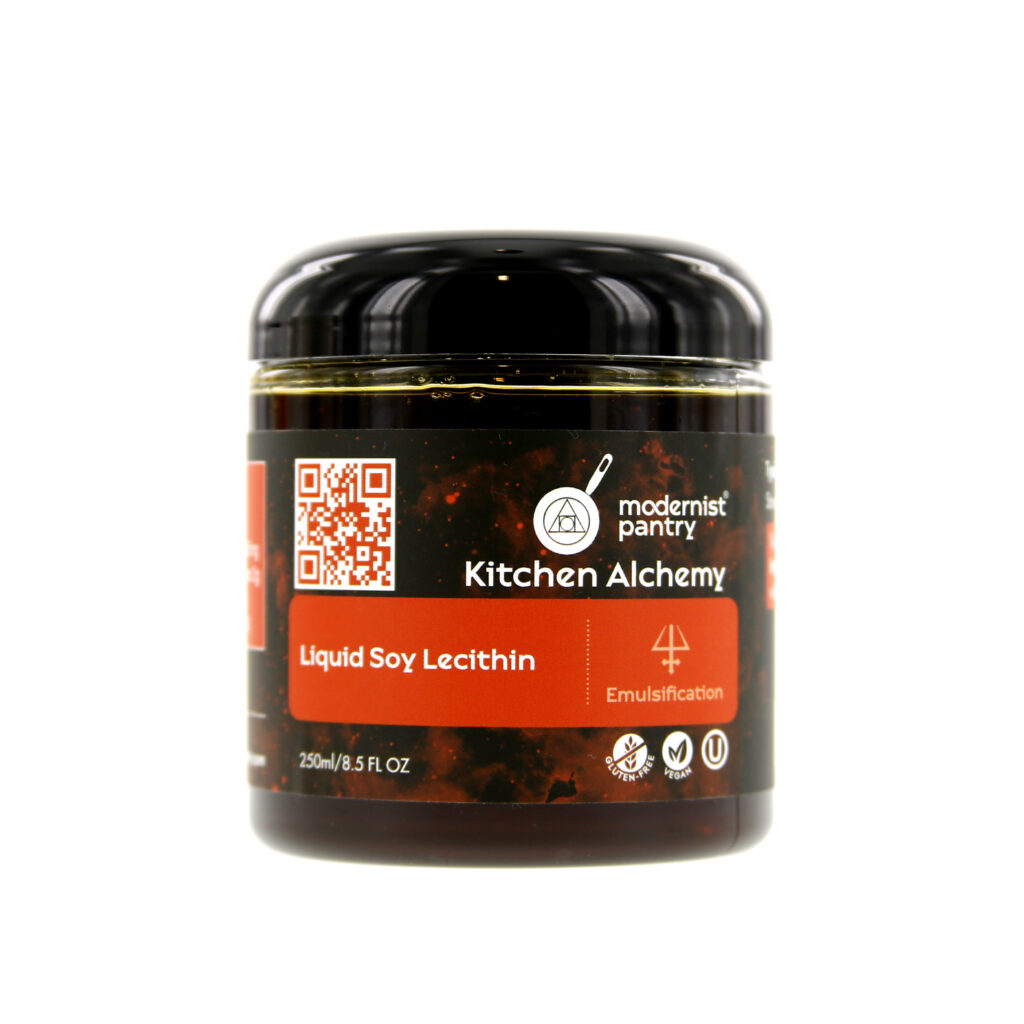
Liquid Soy Lecithin
- Phospholipid from soybeans
- Great for chocolate, cheese, margarine, dressings
- All purpose emulsifier, HLB approximately 4
- Cold/hot soluble, medium viscosity
Liquid Sunflower Lecithin
Liquid Sunflower Lecithin is a viscous emulsifier derived from sunflower seeds and contains a characteristic flavor profile and aroma. Lecithin is a fatty element found in the phospholipid portion of cells in the body and various plants such as sunflowers. Organic sunflower lecithin is widely used in culinary and baking applications due to its emulsifying and antioxidant properties. It helps create a homogeneous mass when making foods such as chocolate, ice cream, processed cheeses and salad dressing.
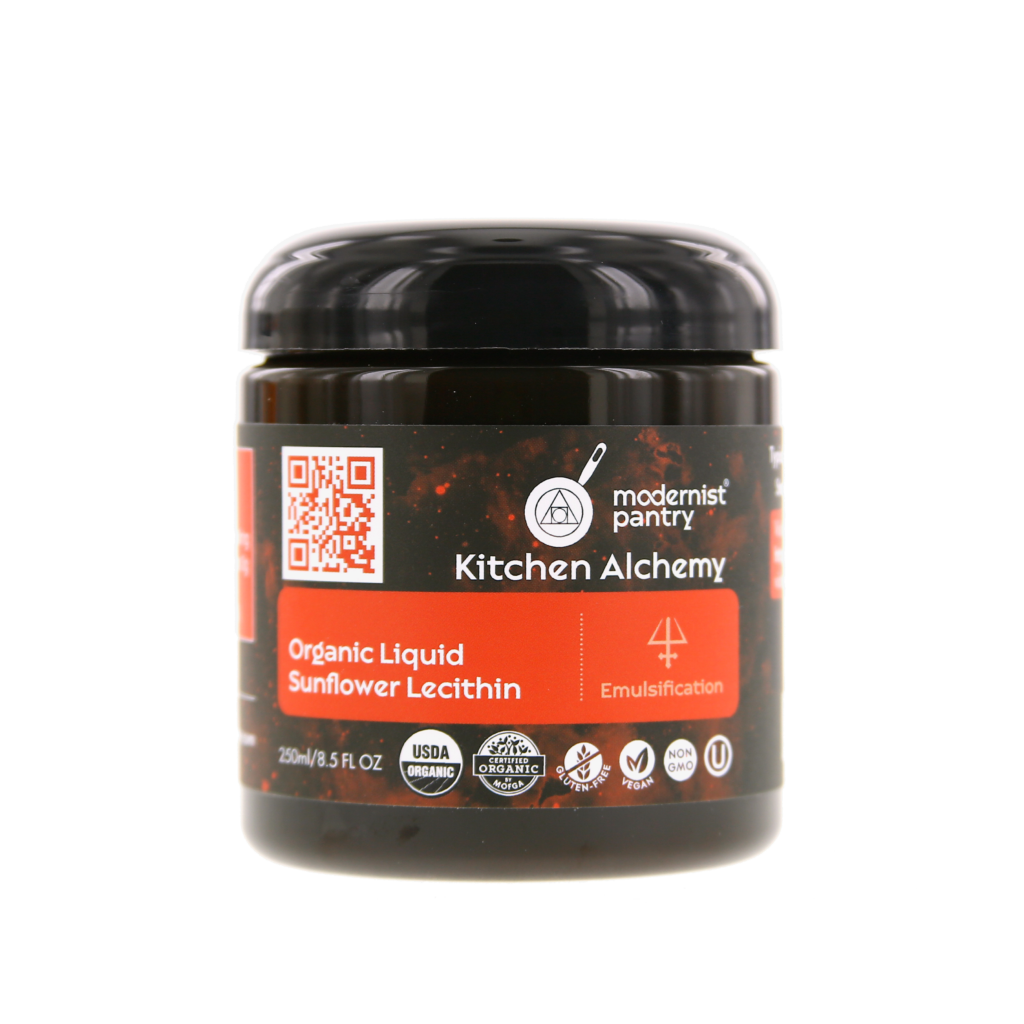
Liquid Sunflower Lecithin
- Organic liquid sunflower lecithin without any additives
- Acts as a powerful emulsifier for oil/fat-based emulsions
- Perfect substitute for liquid soy lecithin – replace using a 1:1 ratio
- Appropriate for baking, chocolate making, ice creams, dressings, etc.
Gummy Coating
Carnauba Wax
Coating with carnauba wax is carried out by dissolving the wax in a flavorless oil (vegetable oil, canola, etc) at 5% the final weight of wax/oil mixture (2.5g carnauba wax to 47.5g oil). This mixture can be heated in the microwave for ease of use. Using gloved hands, drizzle a small amount of coating mixture onto the palm of your hand and massage into your popped gummies. After a light and visible application has been made, toss together in a mixing bowl for several minutes.
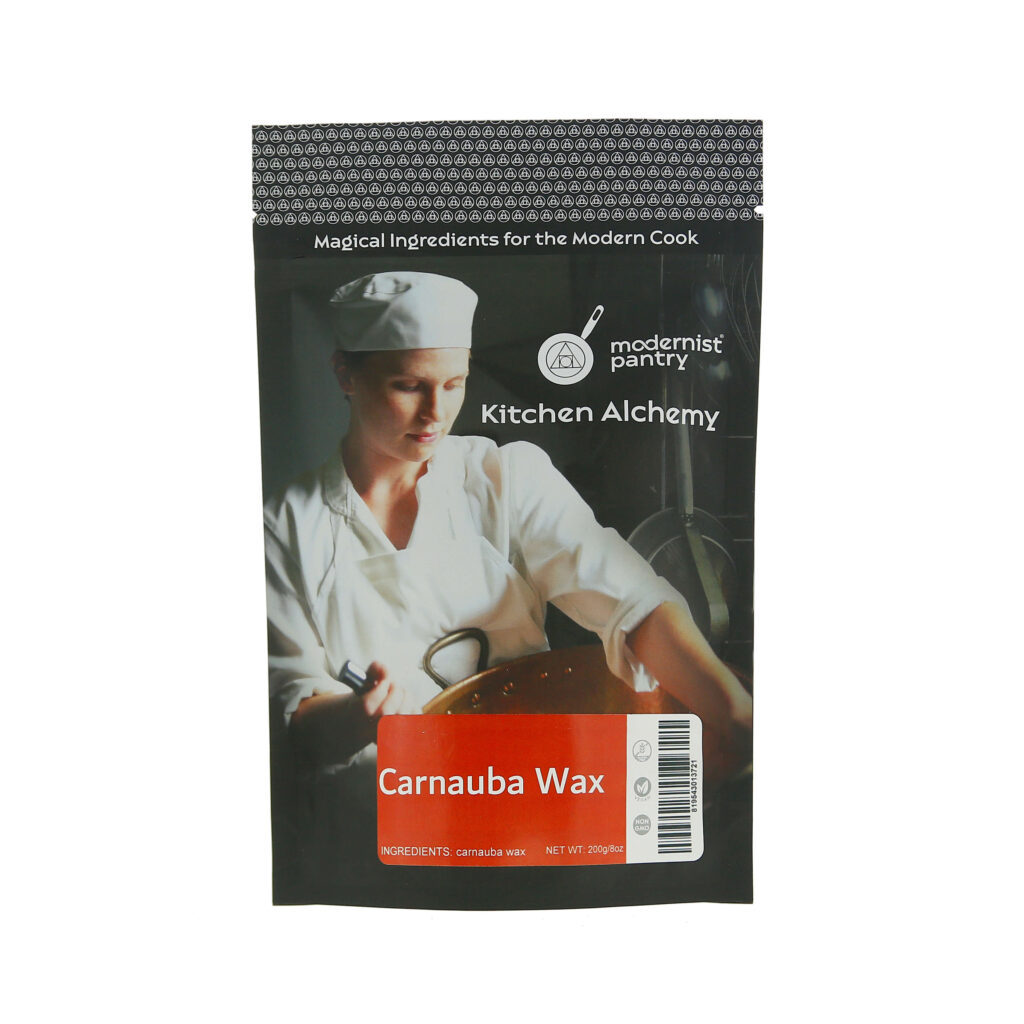
Carnauba Wax
- #1 Yellow Carnauba Wax NF flakes
- Extracted from the leaves of Copernicia cerifera, a palm tree native to Brazil
- Used as a coating on candies to add shine and prevent melting
- Acts as a protective coating on fresh fruits while also making them more physically appealing
- Prevents mold growth and moisture loss when applied as a coating for hard cheeses

